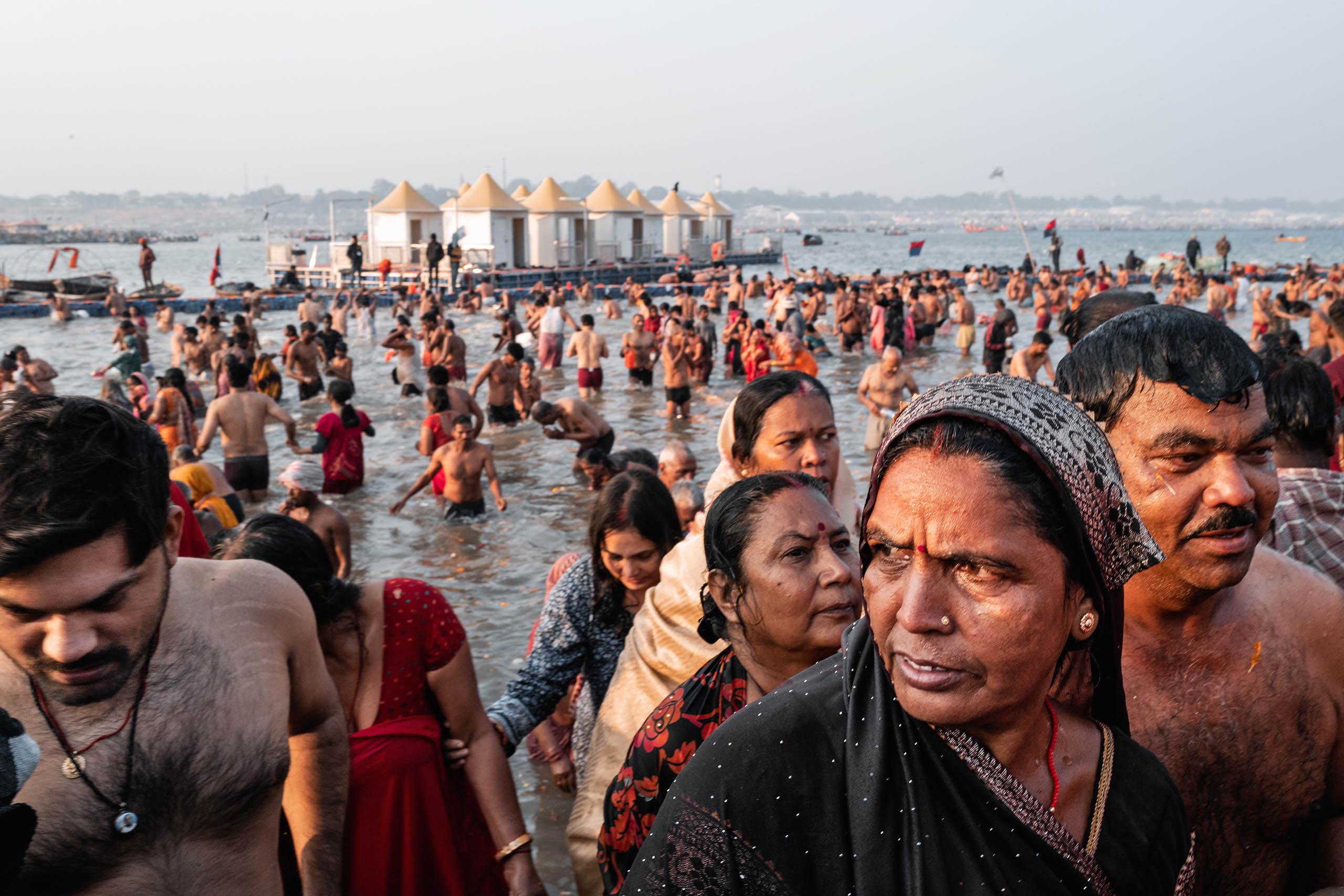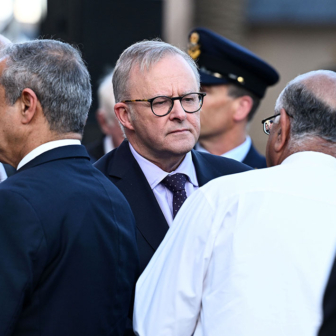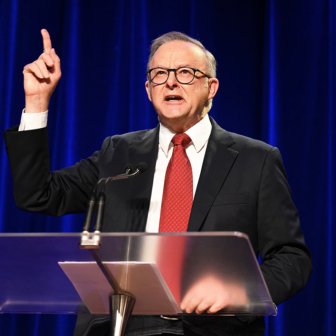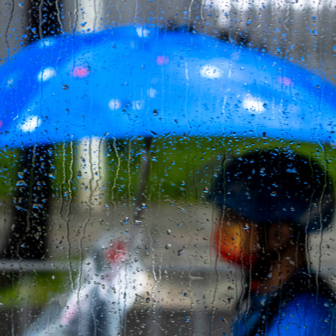“What a crowd,” the elderly Brahmin said. “This year’s arrangements are excellent… yet, look at the chaos.”
He was not referring to the havoc last Tuesday at India’s Maha Kumbh Mela, when crowd control collapsed, thousands of shuffling worshippers tumbled onto each other and up to sixty people were killed and many more injured. He was talking about the Maha Kumbh of 1977, and he made his remark on the most auspicious bathing day of the festival — the same day as the tragedy at this year’s event.
The Maha Kumbh Mela is the six-week Hindu festival proclaimed by UNESCO to be “the largest peaceful congregation of pilgrims on earth,” held at Prayagraj (formerly Allahabad) in Uttar Pradesh. An astrological formula — “when Jupiter is in Aries and the sun and moon are in Capricorn” — produces one every eleven or twelve years. Bathing at the confluence of the Ganga, Yamuna and mythical Saraswati rivers during this time washes away sins and promises escape from the cycle of rebirth.
Devotees claim the festival originated in “time immemorial,” and it certainly has a well-documented history going back more than 200 years. Once the British colonial bureaucracy arrived, the Maha Kumbh Mela became a happening that governments couldn’t ignore.
We know about the old Brahmin’s comment because he had befriended an ill-prepared academic pilgrim, Nabaneeta Dev Sen, a professor of comparative literature at Jadavpur University in Kolkata and the recently divorced wife of economist Amartya Sen. After attending a conference in sunny, southern Hyderabad, she decided on impulse to return home via the much-talked-about festival. In her book The Holy Trail: A Pilgrim’s Plight, she explained how she embarked on an uncomfortable but deeply affecting experience.
“I uttered, ‘Jai Kumbh’,” she wrote, “and took a dip… the water was freezing… I tried to invite other thoughts. This was Triveni Sangam [the confluence of three rivers], the sacred spot;… if someone bathed here during the auspicious hour, one would find release from the bond of rebirth.”
Dev Sen’s newly acquired Brahmin “uncle” held her rain-sodden bag of clothes and handed her the damp bundle when she came out of the water after a few seconds. A veteran of Maha Kumbh Melas in 1954 and 1966, he had taken pity on a lone woman poorly equipped with sandals, a couple of sweaters, a spare sari and a shawl. It had been raining and the night temperature fell to about 10 degrees centigrade.
The intense pressure to make this year’s festival the biggest Maha Kumbh Mela ever — and thereby the biggest gathering of believers in the world — created huge risks. Organisers were expecting an almost incredible 100 million people to bathe in twenty-four hours. The bathing precincts extend about twelve kilometres on both sides of the river, but the most desirable spot is the “nose,” the point where the three rivers (two real, one mythical) meet.
The numbers game is not new, but 2025 is the first Maha Kumbh held while Bharatiya Janata Party governments and Narendra Modi reign supreme. The BJP saw this year’s festival as another building block in the grand façade of a Hindu-supremacist India. One estimate suggests the BJP state government invested $1.2 billion dollars in preparations, and the national government contribution is likely to be no less. Authorities expect the Kumbh to earn many times its cost through the sale of concessions and taxes on huge sales.
Billboards, posters and endless digital content on tens of millions of smart phones proclaim the virtues of the renewed Hindu India and the importance of Narendra Modi and Yogi Adityanath, the chief minister of the state of Uttar Pradesh.
Before this year’s festival began, BJP supporters praised the preparations for an enormous but safe event. They scoffed at the ineptitude of a non-BJP government’s management of the last Mela, in 2013. “How Mahakumbh 2025 Is Fixing the Mistakes of Mahakumbh 2013,” a sympathetic news site proclaimed.
After last week’s chaos and deaths, needless to say, the opposition quickly blamed the government for callous incompetence, especially for the very special treatment given to VVIPs — Very Very Important Persons. Ordinary folk shuffled in endless lines, too tightly packed to be safe, while VVIPs had a direct path to the choicest bathing site barricaded for them and their vehicles.
VVIPs are a reminder of the first Maha Kumbh Mela after independence in 1954, made memorable by a horrific stampede in which more than 350 people died. Vikram Seth devoted a chapter of his bestselling novel A Suitable Boy to the disaster. The newly independent government of Jawaharlal Nehru, also playing the numbers game, had aimed to use the Mela to promote its first Five-Year Plan and impending transformation of the country from poverty to prosperity. The Mela was to have an “educative” as well as a spiritual significance, with a publicity campaign “carried on in such a manner as to make even the uneducated understand the Plan.”
The inquiry into the 1954 disaster put the term “VIP” into Indian languages. Dignitaries, including the president and prime minister, ate a leisurely lunch while hundreds died in a human avalanche a few kilometres away. It was hours before they were aware of what had happened.
At the inquiry into the disaster, desperate officials explained their urgent need to make provisions for “VIPs.” The judge who headed the inquiry deplored the fact that “this unfortunate expression” had “gained currency” and was angered that officials had “allowed the use of, and even used themselves, the expression of ‘V.I.P.’” His outrage did little good. Within ten years, VIP was so overused that a new acronym, VVIP, had become necessary.
Numbers at the Maha Kumbh Mela have long been important for governments. In the nineteenth century, British rulers tended to encourage attendance because it enhanced revenue for the new railways and tax revenue from merchants who provided services.
In January 1942, though, with the Japanese storming through Malaya on the way to Singapore, authorities tried to discourage attendance by stopping the sale of railway tickets to Prayagraj for a month. The pilgrims came anyway.
The British governor of the province accepted what he couldn’t stop, came to the Mela and received “an address of welcome” from “the sadhus and mahants [holymen] of the various akharas [religious sects].” They declared that “the forces of right will ultimately triumph and we shower our blessings on the British and their allies for final victory.” An estimated 800,000 people bathed on that day.
The 1966 festival coincided with the conclusion of a war with Pakistan and the almost simultaneous death of prime minister Lal Bahadur Shastri, who had led the country through the war, and the arrival of Indira Gandhi, Nehru’s daughter, as the new prime minister. Millions of pilgrims that year also returned home to the uncertainties of the Bihar famine.
When Nabaneeta Dev Sen made her impetuous journey to the 1977 Kumbh, Indira Gandhi had been running her authoritarian “emergency” for seventeen months. About to call elections, she flew to the Kumbh to seek the support of the crowds and an assembly of holymen — as the British governor of UP had done in 1942. They presented her with a ceremonial shawl, but by the end of the year she had lost the election and spent a night in prison.
The deaths at this year’s Mela have been played down in Indian media. The largest-selling English print daily, the Times of India, editorialised that it was “important to keep this news in perspective” because “in a gathering as vast as Kumbh, some disorder is almost inevitable.” The paper pointed out that Alzheimer’s disease was the seventh most important cause of death worldwide but such deaths “never make Page 1.” A BJP spokesman agreed: “The tragedy… was most unfortunate” and “there will be criticism that one should take in one’s stride.”
In Chennai, the Hindu, a little bolder, published a piece that highlighted studies showing that when crowds reach a density greater than five people per square metre “the likelihood of death or serious injury is high.”
This year’s deaths have put pressure on the fifty-two-year-old Yogi Adityanath, chief minister of Uttar Pradesh. Adityanath, who wears the saffron robes of a holyman, is seen by many as the eventual successor to the seventy-four-year-old Narendra Modi, but he has rivals as well as explicit political opponents. He sees “a conspiracy” in how the media — especially the foreign media — treated the deaths on 29 January, and sees the coverage as an effort to create “a global embarrassment” and “besmirch the glory of the event.”
In today’s world of disasters, he probably doesn’t have much to worry about. •




